Marietta Kontogianni Interviews Maria Militsi
Maria Militsi
Her art is about collecting existing discarded objects of mass production from flea-markets, from the street or the e-Bay, objects that have suffered a loss; the loss of their owner or the loss of their function and giving them a second life and a new identity by filling their empty spaces with new pieces made of silver, gold, and diamonds in an attempt to bridge the gap between what the object was and what it now is, to turn unwanted into wanted, and to explore questions regarding the role of function and value.
I really love Maria Militsi’s inspiring and versatile art, because it embodies the notion of rebirth. Some of her pieces from the Elia’s T series touched me deep inside, as they reminded me of my fathers’ objects that I have kept in a drawer after his death. It was a big surprise for me when I first saw this body of work on her website, to discover that another man unknown to me, could have owned – for example – glasses that look exactly like my father’s. And that an object’s missing part could be replaced by a piece cast in silver, that could be worn as a pendant. Somehow, I felt connected to Elias T and to Maria. Not only because looking at this work it was as if we shared with Maria the same emotions, but also because she is Greek, and behind her work, I could trace the origins of her native Greek heritage.
I feel very happy that she let me interview her beside her daily busy routine.
You were born in Thessaloniki, but you live and work in London. What made you leave Greece to work abroad?
Curiosity…
How these two different cultures, the Greek and the English one, have influenced your way of thinking and creating so far?
Both Greece and England are imprinted on the making of my work. I was already in my early 30s when I first came to England to study. My status as a newcomer freed me from my own cultural heritage. It provided me with a kind of a filter between myself and my being. It gave me an enormous sense of freedom to build a language, an attitude away from my culture, to step back and reflect… Now in my late 40s, both cultures are an integral part of who I am. My roots and personal history are distilled into my work.
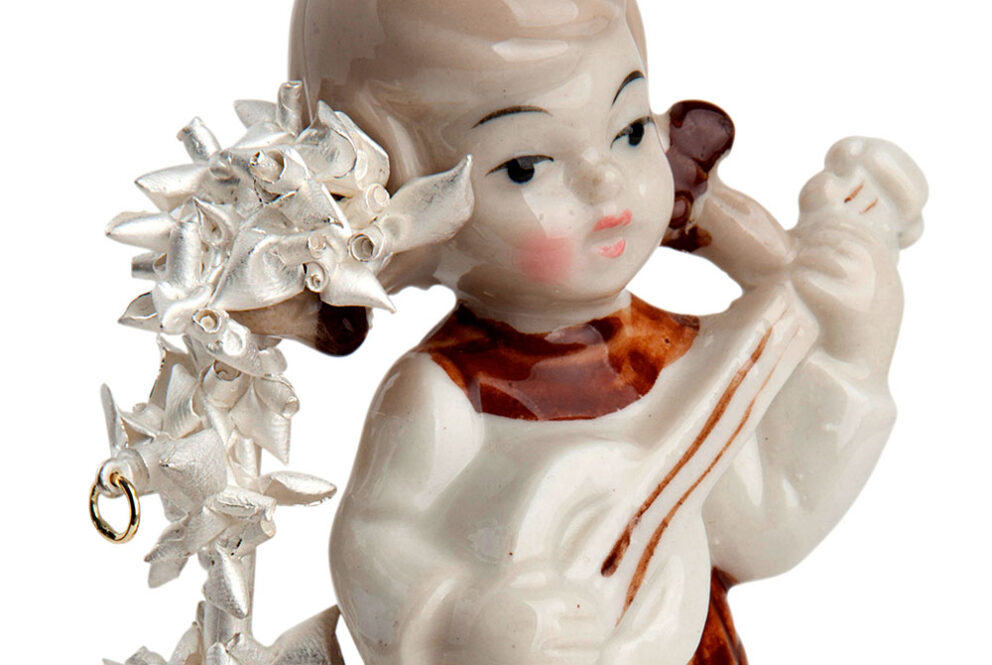
Girl with Guitar (from Floral Studies). Photo by Maria Militsi.

Girl with Guitar (from Floral Studies). Photo by Photo by Maria Militsi.
You work with found objects and I believe the old saying “One man’s trash is another man’s treasure” fits in perfectly with your work. What intrigues you the most about this kind of object?
Somehow, when objects are out of context they demonstrate autonomy and that fascinates me. Fragmented, incidental, mostly unspectacular or of dubious taste, objects seem to exist independent of us, offering all kinds of possible meanings and readings…
Does create new from old make you learn more about your creative power by breaking the boundaries and exploring how far you can go with your work?
An object is not the same in its rebirth. It assumes a new identity that incorporates yet transcends its previous identity. A new piece molded from something old, worthless, defective, or of no use embodies an undeniably creative power.
Working with upcycling of items is it your way of contributing to environmental protection as well? Are you interested in ecology and sustainability?
Absorbing what already exists rather than adding to the world interests me the most… I`m sensitive about how we relate to materiality, how objects are an essential part of life or define us. The excessive production of short-lived disposable items, human life in the dump, and the lack of control over our possessions strongly influence my practice. However, I believe it would be an overstatement to say that I`m contributing to environmental protection.

Ballet to remember. Photo by Maria Militsi.

Ballet to remember. Photo by Maria Militsi.
What is the most peculiar object you have found in your long “hunting down appropriate, evocative objects, researching” and what did you do with it?
An object that found me; a medical gynecological instrument sourced at a flea market and offered to me by Max Warren in 2008, when we were still studying at the Royal College of Art. An odd and suggestive object that now, together with 10 more pieces of the same series, is part of the Crafts Council collection. The series is “choreographed” by a step-by-step guide to ballet published in 1944. BALLET-TO-REMEMBER illustrates a young girl performing positions of ballet. Accordingly, ballet feet as pendants emerge from defunct or overused everyday items.
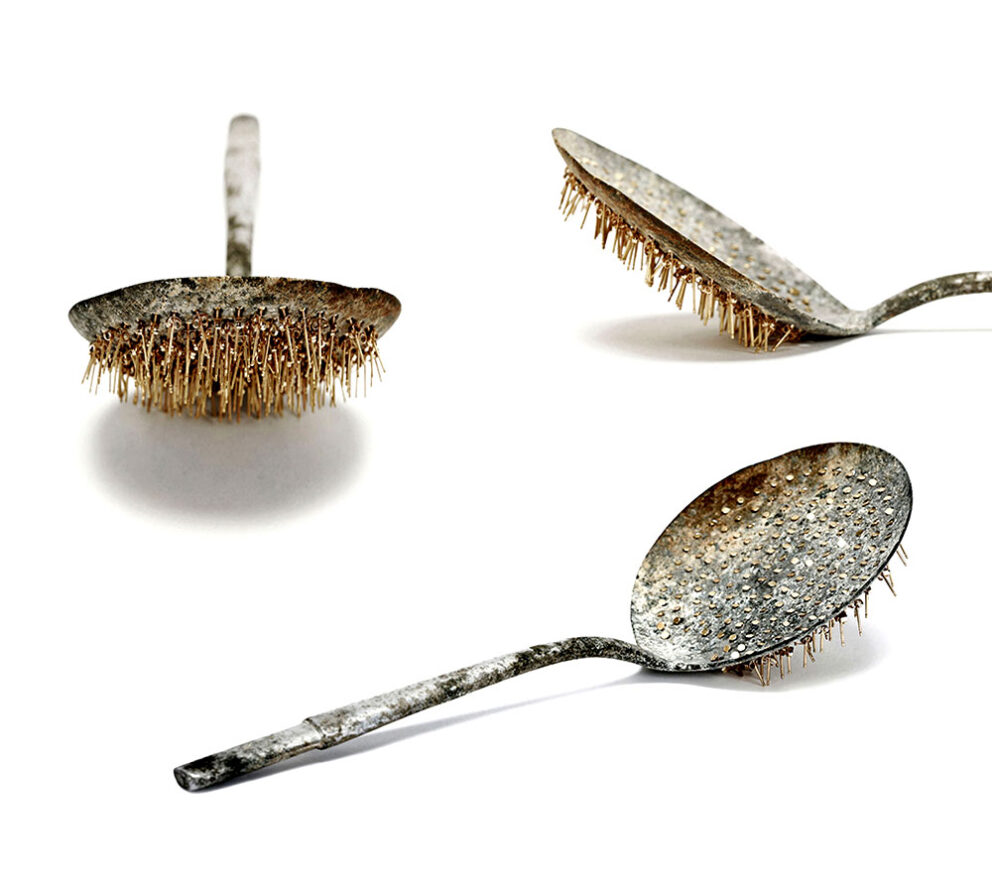
The House of Elias T. Laddle with gold earrings. Photo by Maria Militsi.
In your website, there is a presentation of your work based on Elias T. personal objects. It is so interesting work, but at the same time, it makes me wonder: Why one would like to wear a piece of jewelry made from an evocative object related to someone else’s life?
I agree that a piece of jewelry emerging from a negative space or someone else’s life might appear unappealing, but there is a natural humility in Elia T`s possessions that touched me deeply and I couldn`t resist. These objects gradually started growing in me and it took me 2-3 years to complete the collection – to piece together a narrative from scraps and fragments. This type of work invites one to make their own associations, maybe view it as fellow embodiments of self, reminiscent of something personal, neglected, or forgotten.
What I liked the most among your works, are the pieces you have created to feel in the natural holes of the old objects, or the negative space left after part of the object has been broken. What inner need of yours make you want to fill in the gaps? Is it “kenophobia”, (fear of the empty)? Or is it an intention to bridge the gap between the past, the present, and the future and to connect the former owner of the object to the latter one?
The idea of presence and absence, what we call negative objects, and the way that absence can function drives part of what I`m doing – an impulse to work with the residues, or with the negative spaces, the holes, the spaces in between and draw attention to the lack of function that renders an object defunct. According to German philosopher Heidegger when an object breaks down or is misused, it sheds its socially echoed value and becomes present to us in new ways through the suspension of habit. So, when an object can no longer serve its common function, it becomes something else – I act upon that in an attempt to bridge the gap between what it was and what it now is.
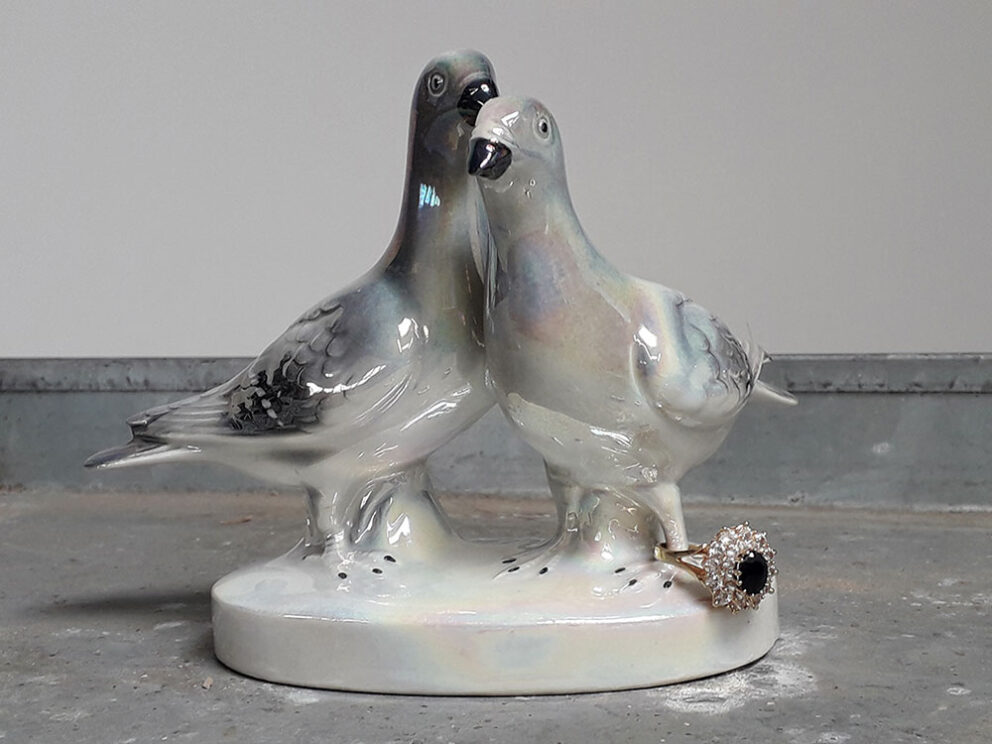
Bibelot (from Polychroni Sisters). Photo by Maria Militsi.
The new pieces you create that fill the empty spaces of the old objects are made of silver, gold, and diamonds. Why do you use so precious materials to complement the old objects?
To turn unwanted into wanted.
Your work is full of contradictions: old-new, trash-gold, negative-positive (space), empty-full, male-female (two rings that fit into one another). Are these contradictions a conscious, deliberate result in your work or an unconscious one that emerges spontaneously through the creative process?
This constant tension between the object and the space it occupies, between precious and non-precious, attractive, and unappealing, is a trigger that causes the development of my work. It`s from an awareness of contrast that ideas are fleshed out…There is intent within the creative process, yet it is in that process that a piece takes on its own life and develops.
I believe your jewelry and art objects carry three different kinds of values: an emotional value related to the old objects regarded as vessels of memory, a material value, more related to the newly crafted jewels because of the precious metals and gemstones used, and of course, a monetary value too, related to the final piece being intended for sale. Which value is more important to you?
There is an interdependent relationship between all three. I embrace them all.
What makes something valuable?
Going through the everyday and real to turn it into something personal and abstract. Stomping through the real to get to the magical.
Is “valuable” a synonym to “precious” and vice versa?
I believe so.
How would you define “preciousness” and what is precious to you?
Turning thoughts into things.
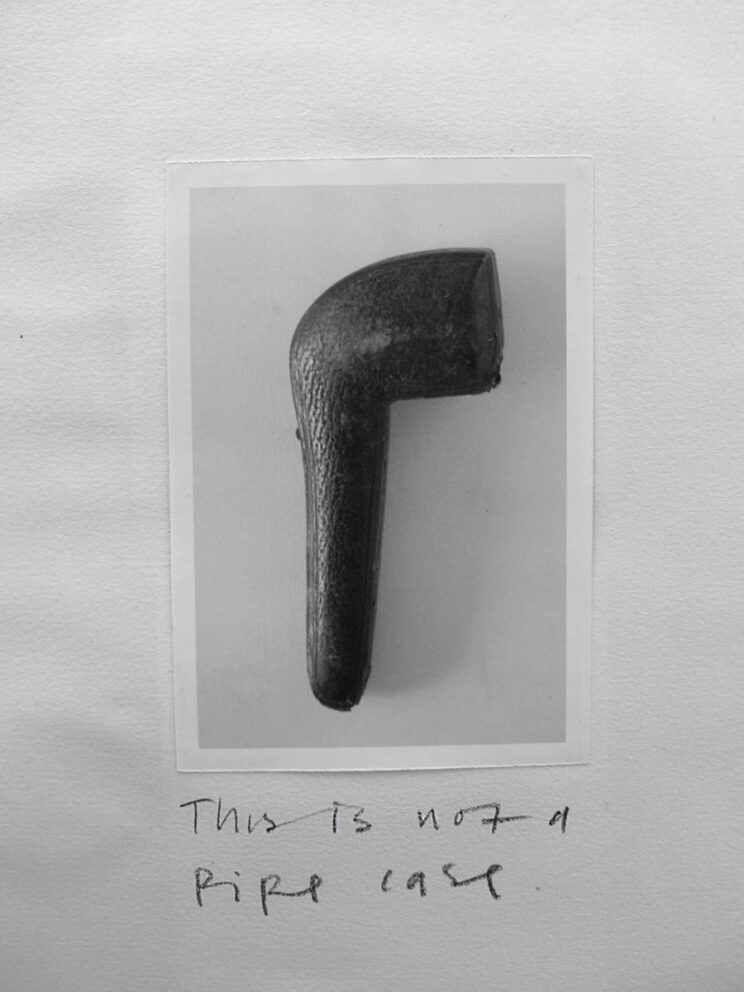
This is Not a Pipe Case. Photo by the author.
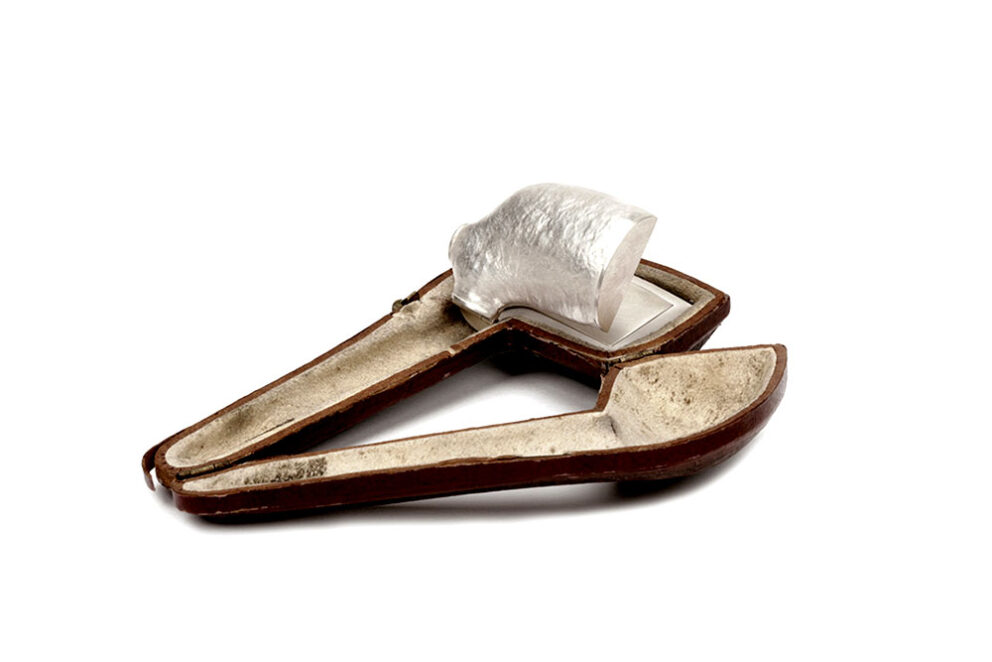
This is Not a Pipe Case. Photo by Maria Militsi.
An old broken object found in a street is characterized as “a trash” with no value. Can the same object shown in a gallery in a totally different context be characterized “a piece of art” of high value?
The idea of the objet trouvé (found object) designated as art or of high value is not new and already widely explored. So yes, it can.
Do you want your works to be regarded as wearable jewelry, collectible pieces of art, or both?
I want my work to be effortlessly communicated regardless a label.
How do people react when they see your works? Do they want to give you their own old objects to make bespoke jewelry or new objects for them?
Yes, there are occasions that people ask me to respond to their own old objects and use them as a point of reference for a new piece.
What is the process you follow in the making of your jewelry, particularly the bespoke jewelry? And which part of the creative process enthusiasts you the most?
I look closely at the person, to what they like and feel comfortable with. Jewelry after all, is something personal and intimate. Making something to fit an individual`s taste or mark an occasion is delightful.


Dirty Badges-Buy One Get One Free. Photo by Maria Militsi.

Dirty Badges-Buy One Get One Free. Photo by Maria Militsi
What is the project you are currently working on?
I always work on several different projects at once, as things take time to settle in my head. I have an ongoing project for example based on the urban refuse I collect. Dirty Badges /Buy One Get One Free, where rubbish such as crisp packets and chocolate wrappers are turned into badges, is part of this. The project revolves around a subject of scholarly interest in the 20th century; the Flâneur / Stroller as an emblematic archetype of urban modern experience, epitomizing the fleeting, ephemeral experience of life in an urban metropolis.
You are the guest artist and one of the lecturers of Athens Jewelry Week 2018. What are you going to show at the central exhibition at the Benaki Museum and what your lecture will be about?
Carpet City – By Appointment Only is work to date and in progress, an intermingling of thoughts and fragmented objects, ideas of domesticity, and recovery. It is also the title of the talk as a reference to an Instagram Tag and the work I’m going to show at Benaki. Carpet City, where I live and work, is a flooring warehouse in north London described by Kimberley Chandler – a researcher, writer and editor that I have been in dialogue with for the last year – as a space awash with invention and reverie, a space where unwanted things have cared for.
https://www.instagram.com/explore/tags/carpetcity_byappointmentonly/?hl=en
About Carpet City – By Appointment Only
Maria Militsi restores and reanimates pre-loved things; so-called “refuse” is her material. She celebrates the faults in things; a thing cast aside she finds fit for repurpose. She pairs her practical knowledge of tools and precious metals with her innate ability to flesh out characters, new stories, and after-lives.
Carpet City, where Militsi both lives and works, is a vast flooring warehouse in Tottenham, north London. This is a space awash with invention and reverie, a place where unwanted things are cared for.
Carpet City – By Appointment Only is a quasi-retrospective: a chance for Militsi to restage, and reflect on her work to date, within the sanctuary of her own space. Works both old and new, highly finished, and ongoing will be interspersed among Militsi’s own belongings, creating a dialogic space that is at once curated and lived in, spectacular and commonplace, purposive and incidental.
/ Kimberley Chandler
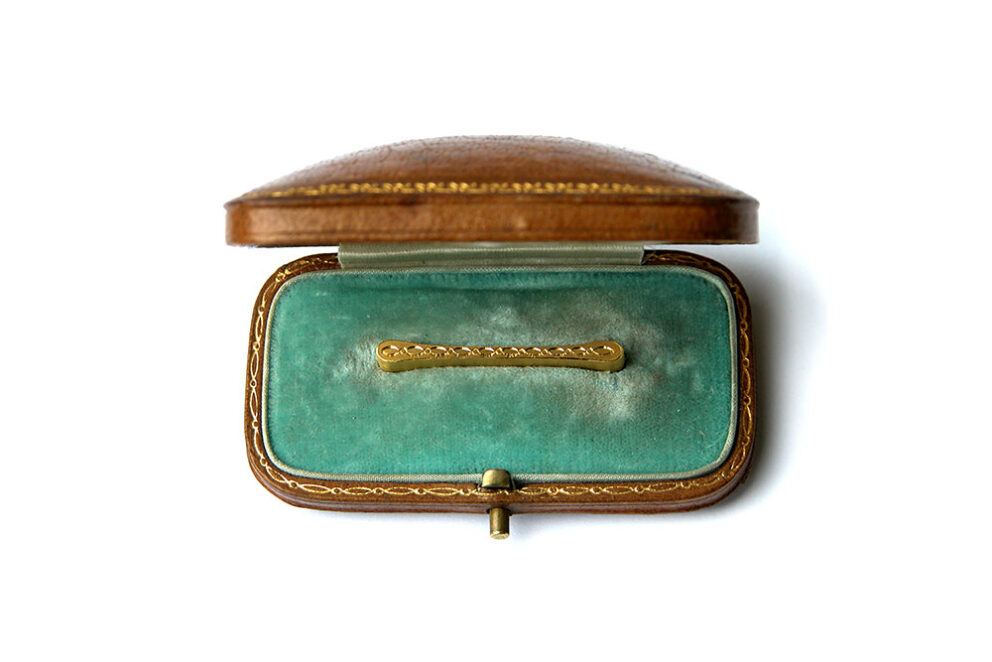
SPINK & SON Pin Case. Photo by the author.
You are also a member of the jury of Athens Jewelry Week 2018. What were your criteria for selecting the participant artists?
I tend to respond to work that is inventive, has a sense of purpose, and radiates joy in the making. It felt like such an indulgence to come across work that is so diverse and original and I`m looking forward to seeing it in the flesh!
What is your opinion about the Greek contemporary jewelry field and what would you advise the emerging artists who want to work in this field in Greece and abroad?
Nearly a decade after the 2009 Greek government-debt disaster, I believe that Greece is undergoing a creative rebirth. It`s great to see that new platforms are emerging from scratch and that the Greek contemporary jewelry field is an integral part of it – Athens Jewellery Week reflects this. It`s hugely promising and exciting to see emerging artists carving out an identity. Niki Stylianou and Erato Kouloubi are driving forces in the field, both as artists and curators, and their involvement with AJW inspires so many people to create new work and be connected to the international jewelry scene and a wider audience.
As for advice, enjoy what you are doing and embrace mistakes, would be my words to an emerging artist who wants to work in this field.
About Maria Militsi
Maria Militsi, Guest Artist & Jury at Athens Jewelry Week 2018, trained at the Mokume School of Jewellery in Greece before gaining a BA (Hons) in Jewellery from Middlesex University (2006) and an MA from the Royal College of Art (2008). Soon after she established her own art-jewelry practice. Since 2012 she has been a lecturer at the Jewellery Design department of Central Saint Martins, University of the Arts in London.
About Marietta Kontogianni
Marietta Kontogianni is a Greek journalist based in Athens.
In April 2016 she founded JEWELRYbox Magazine on Facebook that aims to network with the people involved in the jewelry world. She has been working as a journalist for more than 20 years in newspapers, magazines and TV channels. Meanwhile, she had been creating fashion beaded jewelry herself. When the newspaper she was working for since 1995 bankrupted, she decided to found the bilingual (Greek-English) FB magazineJEWELRYbox to keep on working as a journalist and to express her passion for jewelry.
Up to now, she interviewed almost all of the prominent artists that showed their works in Athens and attended all the lectures given by the renowned artists/ gallerists, curators in Athens since 2016.
Moreover, herJEWELRYbox Magazine was a media sponsor of both Greek jewelry platforms: A Jewel Made in Greece 2017 and Athens Jewelry Week 2017. Her future plan is to have a website built dedicated mainly to the Greek jewelry world.e-mail:[email protected]
Facebook: www.facebook.com/JEWELRYbox-by-Marietta-Kontogianni-493050637486710/
Website and blog on Wix: https://kontogiannimar.wixsite.com/profile
Linkedin: https://www.linkedin.com/in/mariettakontogianni/
Pinterest: https://gr.pinterest.com/jewelryboxmagazine/